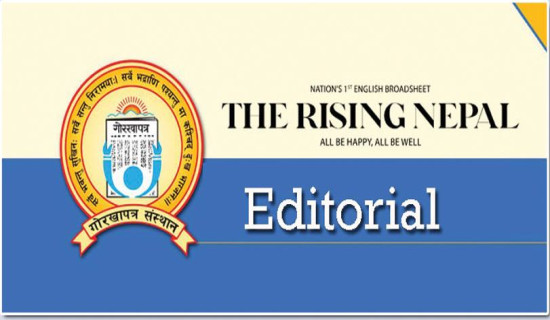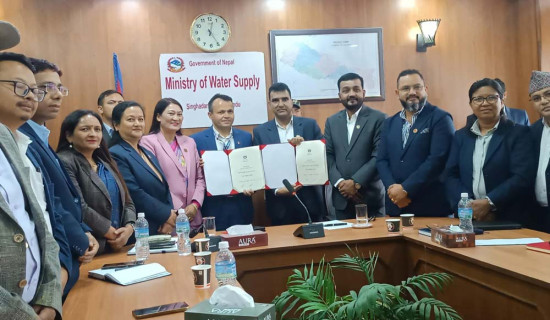- Friday, 9 May 2025
Know Your Spices Better
Nepali food heritage is a culmination of aromatic blends ingrained in traditional cuisines. Spices enhance flavour of meals and enrich it therapeutically. Its use in boosting immunity can be traced to ancient medieval ages. Spices like Turmeric, Coriander, Cumin, Chillies, Fenugreek, Ginger and Garlic are central to an authentic Nepali meal. The use of Cloves, Pepper, Cinnamon, Cardamom, Fennel, Ajowan, Nutmeg, Bay-leaf are limited to special recipes. An indispensable ingredient for cooking, spices need to be free from any form of health hazards, be it chemical, microbial or physical.
The recent international news headlines regarding ban and recall of some popular Indian spice brands has converged global focus towards food safety of spices. It is extremely important to enhance our understanding on it. As the globe observes World Food Safety Day on June 7, this is but a reminder that food safety is everyone’s business.
A wide array of spices is available in the Nepali market, both manufactured at home and abroad. Use of packaged spice powder is increasing due to its convenience and easy availability. Age-old practice of preparing spice powder at home is fading. Some consumers prefer to buy spice from mills where blended spices are sold as per customer requirements. However, some of these outlets still do not adequately label their products. Anonymity of ingredients, uncertainty of its shelf life and absence of traceability could challenge quality and safety. Chapter 6 of Food Rules, 2027 BS of Nepal outlines mandatory labelling requirements for packaged products.
Prescribed limits
Whole or ground spice require compliance to “Mandatory Quality Standard in Food and Feed Products”, 2080 BS, published by Department of Food Technology and Quality Control of the Government of Nepal. “Spice powder” is defined here as a blend of ground spices which should be at least 85 per cent of product weight. Starch and salt are additives permitted within prescribed limits. The powder should be free from insect infestation, mold or any impurities. Taste enhancers like Monosodium glutamate or any identical flavoring agent is not permitted. Its mandatory specification includes safety parameters like Moisture (not exceeding 14 per cent by weight), Ash (not exceeding 10 per cent by dry matter basis), Acid Insoluble Ash (not exceeding 1.5 per cent on dry matter basis) and Lead (not exceeding 10 ppm by dry matter basis).
Moisture accelerates microbial growth and rancidity. Total Ash indicates amount of salt, minerals and siliceous matter. Acid Insoluble Ash denotes silica content which indicates impurities. Lead contamination occur from soil, ground water, or from equipment. Its long-term exposure elevates blood pressure and causes disorders in cardiovascular, renal, reproductive, skeletal and nervous system. These parameters should hence be strictly monitored.
On April 5, 2024, The Centre for Food Safety of Hongkong issued a public notice banning some brand of Indian spices due to excess amount of ethylene oxide. Singapore and Maldives followed suit. On May 18, Nepal Government banned the import, sale and supply of four types of spices of two popular Indian brands. The Department of Food Technology and Quality Control issued a public notice to importers and traders to recall non-complying products and directed National Food and Feed Reference Laboratory to prioritise analysis of ethylene oxide. Ethylene oxide (EO or EtO) is a common fumigant used within industries to sterilize medical devices and supplies. In some countries, it is used to prevent E. Coli and Salmonella contamination. EtO, if not aerated properly, can remain in food as residues, leading to formation of toxic compounds. The International Agency for Research on Cancer classifies ethylene oxide as a Group 1 carcinogen. The European Union banned the use of ethylene oxide for food fumigation in 1991. In June 2023, United States Food and Drug Administration notified traders to recall some brands of Indian spices after they tested positive for Salmonella. Salmonella intoxication causes diarrhea, fever, vomiting and can impact central nervous system in severe cases.
The Food Safety and Quality Act, 2081 of the Government of Nepal defines the role of manufacturers, processors, suppliers, transporters, storekeepers and retailers to ensure food safety. Establishment of prerequisite programmes in the processing facility as per Good Manufacturing Practices and Good Hygiene Practices is imperative. Implementation of “Hazard Analysis and Critical Control Point” is beneficial. Precaution should be taken to ensure no contamination occurs during processing and storage. Protocols on store fumigation, including type of fumigant, dosage, exposure time and efficacy of aeration (flushing out of fumigant) should be stringently followed. Users need to be aware about product shelf life. Spices are hygroscopic, hence packages once opened should always be stored in airtight containers.
Stringent quality assurance
Spices are the soul of Nepali cooking. Ensuring safety of spice calls for stringent quality assurance during its processing. While non-compliances in some parameter of spices may manifest in visible health issues, discrepancies in others may lead to long-term health implications. Market recalls and ban on noncomplying food is only a correction. Processors need to focus on strategies to ensure compliance to food quality and safety at all times. Consumers need to be alert on food safety issues already in the public domain and heed to government directives. Purchasing spices manufactured by firms certified with food or quality management system is a way forward. Likewise, relying on organic produce is another way out. The role of government in ensuring food safety is pivotal. Every food outlet, be it a branded mart or a neighbourhood spice mill, needs to be closely monitored. It is time we together build a robust food safety system so that we can savor our spices and enrich our spice legacy.
(The author is a Food Technologist and can be contacted at monicakpg@yahoo.com).

















